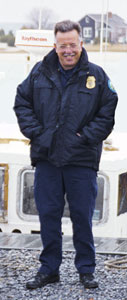Enforcers Lower The Boom
Enforcers Lower The Boom
Erosion Expert's Revetment Cited
Rhodes W. Fairbridge, a professor emeritus of geology at Columbia University who is considered an expert on coastal erosion, has been charged with violating the East Hampton Town Code.
According to papers filed in Justice Court, Mr. Fairbridge allegedly built an illegal 75-foot rock revetment on town property next to his Fresh Pond Road, Amagansett, house, which looks out onto Gardiner's Bay. Mr. Fairbridge was not present for a court appearance scheduled for Monday.
Mr. Fairbridge explained on Tuesday, from his other home in Manhattan, that the town's notice was sent on Nov. 14 to his Manhattan address but that he and his wife, Dolores, were still in Amagansett at the time. They returned to Manhattan for the winter on Monday, he said, and found the notice in their mail.
Answering Charges
According to information filed by James Cavanagh, assistant natural resources director for the town, Mr. Fairbridge is accused of building "an approximately 75-foot revetment on town property in the parking lot on Fresh Pond Road, adjacent to his residence," without a natural resources permit or a building permit.
A line of boulders, perhaps 30 feet in length, on what appears to be town property in front of the road-end parking area, was visible on a recent visit. Mr. Cavanagh said Tuesday that he could not make any comments on the case at this time.
He was writing a letter to Justice Roger W. Walker to explain why he was not present in court as well as to answer the charges "at considerable length," Mr. Fairbridge said on Tuesday. Because the judge has not yet received the letter, Mr. Fairbridge did not want to discuss the charges at much length, he said.
Beach Erosion
He did say that he believed he had a current permit to construct the rock revetment at issue, adding that he and his wife believe the permit is valid until 1998, although he could not recall whom the permit was issued by. No record of any such permit was in the files of the Town Zoning Board of Appeals, which issues natural resources permits for activities within 150 feet of protected features, such as the beach.
A 1985 permit from the Zoning Board did give the Fairbridges permission to rebuild and repair the inner and higher sea wall and outer and lower wooden bulkhead which still exist on the bay side of their house. The bulkhead ties into a town-owned bulkhead seaward of the road end.
Mr. Fairbridge also said, as he has expressed in the past, that erosion of the bay beach in the area of his house has been caused by the two Fresh Pond jetties, which he said should be removed, and the town's bulkhead, which he said should be made taller and repaired.
Jetties In Question
Mr. Fairbridge, honorary president of the Quaternary Union Shorelines Commission and associate editor of the Journal of Coastal Research, also recommends building offshore breakwaters in the area.
His observations and recommendations for the bay beach around his home were the subject of a Guestwords in the Jan. 19, 1995, issue of The Star.
Discussions among the East Hampton Town Trustees, the town's engineering consultant, and the State Department of Environmental Conservation on the possibility of shortening or removing the northern Fresh Pond jetty were reported in The Star last month.
Hard structures, both parallel and perpendicular to the shoreline, have been praised for protecting shoreline properties by some, but also have been criticized for affecting the natural flow of sediment and hastening erosion in front of and downdrift of the property where they are installed.

